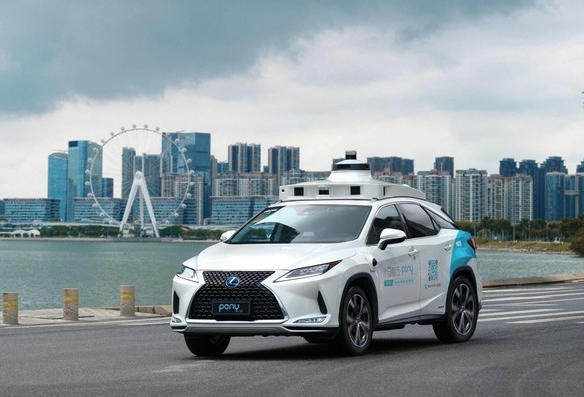 Technology peripherals
Technology peripherals
 It Industry
It Industry
 Pony.ai's Robotaxi launches in the core urban area of Shenzhen, allowing citizens to enjoy unmanned travel
Pony.ai's Robotaxi launches in the core urban area of Shenzhen, allowing citizens to enjoy unmanned travel
Pony.ai's Robotaxi launches in the core urban area of Shenzhen, allowing citizens to enjoy unmanned travel
News on September 25th: Recently, Shenzhen City granted Pony.ai its first municipal-level unmanned demonstration application license, which marks that Shenzhen has become the first country in China to allow the provision of L4 unmanned autonomous driving travel services in core urban areas. (Robotaxi) city. Pony.ai has previously successfully launched fully unmanned autonomous driving travel services in first-tier cities such as Beijing and Guangzhou. It is also one of the first autonomous driving companies to obtain unmanned testing qualifications in the four first-tier cities of Beijing, Shanghai, Guangzhou and Shenzhen.

It is understood that Shenzhen citizens can now use the Pony.ai travel software App PonyPilot By placing an order, you can experience unmanned self-driving vehicles in the Qianhai area of Shenzhen. Passengers only need to sit in the back seat, click the "Start Trip" button on the screen, and the vehicle will start smoothly. Pony.ai's unmanned self-driving service has opened nearly 150 stations in Shenzhen, covering high-frequency travel destinations such as subway stations, parks, business districts, and residential areas. The service hours are from 8:30 a.m. to 10:30 p.m. , meeting the needs of morning and evening peak travel.

According to my understanding, Pony.ai obtained the only “Intelligent Connected Vehicle Unmanned Testing” license in Shenzhen in May this year, and officially launched it in Shenzhen Core An unmanned test of autonomous driving with "no safety officer in the main driver's seat" was conducted in the urban area. With its powerful virtual driver generalization capabilities, Pony.ai is able to more proficiently cope with the complex road conditions in the core area of Shenzhen. Obtaining the unmanned demonstration application license this time means that Pony.ai’s Robotaxi service has entered the stage of unmanned, large-scale and commercialization, and will play a leading and demonstrative role in the development of the domestic autonomous driving industry. So far, Pony.ai’s autonomous driving has traveled 25 million kilometers, of which unmanned driving has reached 250,000 kilometers.
This news shows that China has made significant progress in the field of autonomous driving. Shenzhen’s The demonstration application license also takes an important step towards the commercial application of autonomous driving technology. Pony.ai’s leading position is expected to promote the popularization and maturity of autonomous driving technology in the Chinese market
The above is the detailed content of Pony.ai's Robotaxi launches in the core urban area of Shenzhen, allowing citizens to enjoy unmanned travel. For more information, please follow other related articles on the PHP Chinese website!

Hot AI Tools

Undresser.AI Undress
AI-powered app for creating realistic nude photos

AI Clothes Remover
Online AI tool for removing clothes from photos.

Undress AI Tool
Undress images for free

Clothoff.io
AI clothes remover

Video Face Swap
Swap faces in any video effortlessly with our completely free AI face swap tool!

Hot Article

Hot Tools

Notepad++7.3.1
Easy-to-use and free code editor

SublimeText3 Chinese version
Chinese version, very easy to use

Zend Studio 13.0.1
Powerful PHP integrated development environment

Dreamweaver CS6
Visual web development tools

SublimeText3 Mac version
God-level code editing software (SublimeText3)

Hot Topics
 1389
1389
 52
52
 Building a Network Vulnerability Scanner with Go
Apr 01, 2025 am 08:27 AM
Building a Network Vulnerability Scanner with Go
Apr 01, 2025 am 08:27 AM
This Go-based network vulnerability scanner efficiently identifies potential security weaknesses. It leverages Go's concurrency features for speed and includes service detection and vulnerability matching. Let's explore its capabilities and ethical
 CNCF Arm64 Pilot: Impact and Insights
Apr 15, 2025 am 08:27 AM
CNCF Arm64 Pilot: Impact and Insights
Apr 15, 2025 am 08:27 AM
This pilot program, a collaboration between the CNCF (Cloud Native Computing Foundation), Ampere Computing, Equinix Metal, and Actuated, streamlines arm64 CI/CD for CNCF GitHub projects. The initiative addresses security concerns and performance lim
 Serverless Image Processing Pipeline with AWS ECS and Lambda
Apr 18, 2025 am 08:28 AM
Serverless Image Processing Pipeline with AWS ECS and Lambda
Apr 18, 2025 am 08:28 AM
This tutorial guides you through building a serverless image processing pipeline using AWS services. We'll create a Next.js frontend deployed on an ECS Fargate cluster, interacting with an API Gateway, Lambda functions, S3 buckets, and DynamoDB. Th



